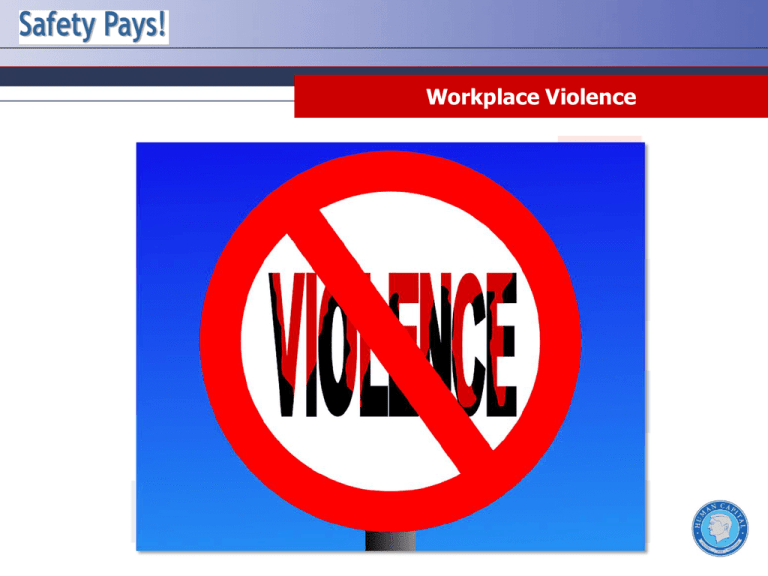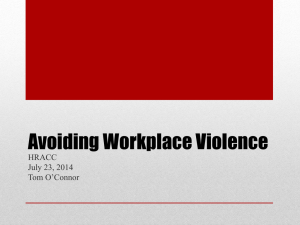Workplace Violence Training
advertisement

Workplace Violence Disclaimer • This training material presents very important information. • Your organization must do an evaluation of all exposures, applicable codes and regulations, and establish proper controls, training, and protective measures to effectively control exposures and assure compliance. • This program is neither a determination that the conditions and practices of your organization are safe nor a warranty that reliance upon this program will prevent accidents and losses or satisfy local, state or federal regulations. • All procedures and training, whether required by law or not, should be implemented and reviewed by safety and risk management professionals, and legal counsel to ensure that all local, state and federal requirements are satisfied. Course Outline – Workplace Violence 1. Why Take Workplace Violence Training? 2. What is Workplace Violence? 3. Workplace Violence Factors 4. Violence Prevention Program 5. Training Guidelines 6. Recordkeeping and Evaluation 7. Summary 8. Resources Why Take Workplace Violence Training? Workplace violence training is important: • Homicide is one of the leading causes of fatalities in the workplace every year. • Women are more likely than men to be a victim of a violent crime. • Retail establishments have the largest share of homicides in convenience and grocery stores, eating and drinking places, and gasoline service stations. Why Take Workplace Violence Training? Violent crime statistical comparison: 1600000 1400000 1200000 1000000 800000 600000 simple assaults aggravated assaults rapes, sexual assaults robberies homicides 400000 200000 0 Assaults and violent threats exceed 2 million incidents a year. Simple assaults exceed 1.5 million a year. Why Take Workplace Violence Training? Economic impact of workplace violence: • Costs 500,000 employees about 1,175,100 lost work days each year. • Lost wages exceed $55 million annually. • Lost productivity, legal expenses, property damage, diminished public image and increased security totals in the billions. What is Workplace Violence? Workplace violence defined: • Any physical assault, threatening behavior, or verbal abuse occurring in the work setting. • The most common type of workplace fatality is a shooting during the robbery of a retail, service or transportation worker. What is Workplace Violence? Workplace violence includes: • Beatings • Stabbings • • • • • Suicides Shootings Rapes Near-suicides (attempted) Psychological traumas • Threats • Obscene phone calls • Intimidation • Harassment of any nature • Being stalked • Verbal abuse, e.g. swearing, shouting What is Workplace Violence? Examples of workplace violence: • Verbal threats to inflict bodily harm, e.g., vague or covert threats. • Attempting to cause physical harm, e.g., striking, pushing, other aggressive physical acts against another person. • Verbal harassment, e.g., abusive or offensive language, gestures or other discourteous conduct towards anyone. • Disorderly conduct, e.g., shouting, throwing or pushing objects, punching walls, slamming doors. What is Workplace Violence? Examples of workplace violence (continued): • Making false, malicious or unfounded statements against coworkers, supervisors, or subordinates which tend to damage their reputations or undermine their authority. • Inappropriate remarks or making delusional statements. • Fascination with guns and weapons, or bringing them into the workplace (depending on the situational context and company policy, this could be construed as a threat). Workplace Violence Factors Some common causes: • Mentally ill patients: – An increasing number of acute and chronically mentally ill patients are being released from hospitals without follow-up care. – They are often not hospitalized involuntarily unless they pose a threat to themselves or others. – They often have the right to refuse medication. • Trauma patients • Distraught family members • Gang members Workplace Violence Factors Some common causes (continued): • Insufficient hospital security: – Unrestricted movement of the public in clinics and hospitals. – Low staffing levels during times of increased activity such as meal and visiting times, or when transporting patients. • Proliferation of the drug epidemic: – Drugs at hospitals, clinics, and pharmacies make them likely robbery targets. Workplace Violence Factors Workplace risk factors to be aware of: • Personal contact with the public. • Exchanging of money. • Delivery services. • Mobile workplaces, e.g. taxicab, police cruiser, security detail. • Solo work in remote or high crime settings, without back-up means for obtaining assistance. • Environments with limited communication or without security systems. Workplace Violence Factors Workplace risk factors to be aware of (continued): • Working alone or in small numbers. • Working late, at night, or during early morning hours. • Poorly-lighted parking areas. • Guarding valuable property or possessions. • Isolated work with clients during exams or treatment. • Lack of training in recognizing and managing escalating hostile and aggressive behavior. Violence Prevention Program Elements of a violence prevention program: • Management commitment • Employee involvement • Worksite analysis • Hazard prevention and control • Employee training • Recordkeeping and evaluation Violence Prevention Program Management commitment motivates: • Take all threats of incidents seriously. • Develop a zero tolerance prevention policy. • Develop a reporting process. • Develop a site security plan. • Partner with police, associations, and landlords to improve security. • Assign responsibility, authority and resources. • Hold employees accountable and encourage involvement. Violence Prevention Program Employee involvement: • Employee involvement and feedback will enable workers to show their commitment. They can: – Participate in surveys and offer suggestions. – Assist in security analysis and inspection. – Help evaluate prevention and control measures. – Train other employees. – Share on-the-job experiences with other employees. • Employees who report problems or an incident must not be punished or discriminated against. Violence Prevention Program Perform a worksite hazard analysis: • Conduct a step-by-step, common sense look at the workplace to find existing and potential hazards: ‒ Review records and past incidents ‒ Perform a workplace security analysis ‒ Carry out periodic safety audits • Develop a team to assess vulnerability to workplace violence and determine appropriate actions. ‒ Analyze and track records ‒ Monitor trends and analyze incidents ‒ Screen surveys ‒ Analyze workplace security Violence Prevention Program Types of preventive control measures: 1. Engineering controls and workplace adaptation. 2. Administrative and work practice controls. 3. Post incident response. These prevention strategies do work: • The risk of robbery can be reduced by: ‒ Increasing the effort a perpetrator must expend. ‒ Increasing the perpetrator’s risks. ‒ Reducing the prospect of perpetrator rewards. Violence Prevention Program 1. Engineering controls: • Visibility and lighting • Metal detectors • Drop safes • Video surveillance • Height markers • Door detectors, buzzers • Alarms • Bullet resistant barriers • Safe rooms for use during emergencies • Deep service counters or bullet-resistant glass Violence Prevention Program 2. Administrative and work practice controls: • Integrate violence prevention into daily procedures. • Be clear that violence will not be tolerated or permitted. • Keep minimal cash in the register. • Set up emergency procedures, systems of communication. • Use barriers and enclosures. • Increase staffing at high risk locations and/or times. • Establish a liaison with local police and state prosecutors. Violence Prevention Program 2. Administrative and work practice controls (continued): • Require employees to report all assaults and threats. • Set up trained response teams to respond to emergencies. • Lock delivery doors. • Establish rules for workers leaving facility. • Lock doors when not open. • Have procedures for opening and closing doors. • Limit access. • Adopt safety procedures for off-site work. Violence Prevention Program 3. Post incident response: • Get medical care for injured victims. • Report to police and other authorities. • Inform management. • Secure the premises – safeguard evidence. • Prepare incident report immediately. • Employee assistance programs for victims. • Arrange psychological treatment for victims: – Trauma-crisis counseling – Critical incident stress debriefing Training Guidelines Staff awareness of security hazards and protective procedures: • All employees should be trained in: ‒ Potential risks ‒ Operational procedures ‒ Use of security measures ‒ Behavioral strategies ‒ Incident response ‒ Emergency action plan Training Guidelines Supervisors, managers, and security personnel: • Must have the same training as all other workers. • Additional training must be provided to help them recognize, analyze and establish controls. Training Guidelines Important elements to teach employees: • Concept of “universal precautions for violence”, i.e., violence should be expected but can be avoided or mitigated through preparation. • The importance of limiting physical interventions in workplace altercations, except in the case of designated emergency response team or security personnel. Other key concepts: • Learn the workplace violence prevention policy. • Know the risk factors that cause or contribute to assaults. • Know how to recognize escalating behavior or warning signs. • Learn ways to prevent volatile situations. • Know the standard response action plan for violent situations. • Be aware of the location and operation of safety devices. Recordkeeping and Evaluation Purpose of keeping records: • Recordkeeping and evaluation of the violence prevention program is necessary to determine the overall effectiveness of the program. • It helps identify deficiencies or changes that should be made. Recordkeeping and Evaluation Keep detailed records of the following: • Incident reports, e.g. abuse, verbal attacks, aggressive behavior. • Medical reports, e.g. work injuries or assaults. • Hazard analyses and corrective actions. • Training and safety meetings minutes. • OSHA log of injury and illness. • Information on people with history of violence. • Recommendations from police, consultants, and employees. Recordkeeping and Evaluation Evaluation: • Establish a uniform violence reporting system. • Regularly review the results of safety audits. • Review post-incident reports. • Review minutes from safety meetings. • Analyze trends in incidents, injuries, etc. • Consult with employees before and after worksite changes. • Update information on violence prevention strategies. • Measure trends and improvements on a recurring schedule. Summary Summary: • The statistics: Homicide is the 2nd leading cause of workplace • Workplace violence defined: Any physical assault, threatening • Employer responsibility: Employers have a general duty to provide • Management commitment: It is essential to provide a motivating deaths. behavior, or verbal abuse occurring in the work setting. their employees with a workplace free from recognized hazards likely to cause death or serious physical harm. force to deal effectively with workplace violence. Summary Summary (continued): • Employee involvement and feedback: Enables workers to develop • Preparation is the key: Violence should be expected but it can be • Recordkeeping and evaluation: Analysis of the violence prevention and express their commitment to safety and health. avoided or mitigated through specific preventive measures. program helps determine overall effectiveness and to identify deficiencies or changes that should be made. Don’t let workplace violence come as a surprise. Managers and employees must take the time to be trained and equipped. Recognition of the danger signs facilitates appropriate preventive and responsive measures. Resources Additional resources: • OSHA Internet Site www.osha.gov • OSHA State Programs • NIOSH Workplace Violence This form documents that the training specified above was presented to the listed participants. By signing below, each participant acknowledges receiving this training. Organization: Trainer: Trainer’s Signature: Class Participants: Name: Signature: Date: Name: Signature: Date: Name: Signature: Date: Name: Signature: Date: Name: Signature: Date: Name: Signature: Date: Name: Signature: Date: Name: Signature: Date: Name: Signature: Date: Name: Signature: Date: Name: Signature: Date: Name: Signature: Date: Name: Signature: Date:









